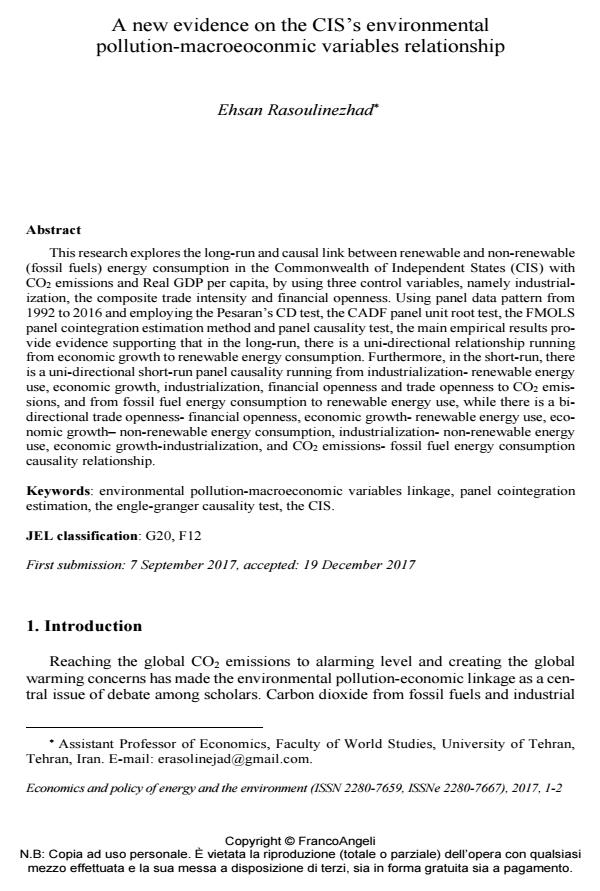A new evidence on the CIS’s environmental pollution-macroeoconmic variables relationship
Journal title ECONOMICS AND POLICY OF ENERGY AND THE ENVIRONMENT
Author/s Ehsan Rasoulinezhad, Farhad Taghizadeh-Hesary
Publishing Year 2017 Issue 2017/1-2
Language English Pages 21 P. 273-293 File size 390 KB
DOI 10.3280/EFE2017-001014
DOI is like a bar code for intellectual property: to have more infomation
click here
Below, you can see the article first page
If you want to buy this article in PDF format, you can do it, following the instructions to buy download credits

FrancoAngeli is member of Publishers International Linking Association, Inc (PILA), a not-for-profit association which run the CrossRef service enabling links to and from online scholarly content.
This research explores the long-run and causal link between renewable and non-renewable (fossil fuels) energy consumption in the Commonwealth of Independent States (CIS) with CO2 emissions and Real GDP per capita, by using three control variables, namely industrialization, the composite trade intensity and financial openness. Using panel data pattern from 1992 to 2016 and employing the Pesaran’s CD test, the CADF panel unit root test, the FMOLS panel cointegration estimation method and panel causality test, the main empirical results provide evidence supporting that in the long-run, there is a uni-directional relationship running from economic growth to renewable energy consumption. Furthermore, in the short-run, there is a uni-directional short-run panel causality running from industrialization- renewable energy use, economic growth, industrialization, financial openness and trade openness to CO2 emissions, and from fossil fuel energy consumption to renewable energy use, while there is a bi-directional trade openness- financial openness, economic growth- renewable energy use, economic growth-non-renewable energy consumption, in-dustrialization- non-renewable energy use, economic growth-industrialization, and CO2 emissions- fossil fuel energy consumption causality relationship.
Keywords: Environmental pollution-macroeconomic variables linkage, panel cointegration estimation, the engle-granger causality test, the CIS
Jel codes: G20, F12
Ehsan Rasoulinezhad, Farhad Taghizadeh-Hesary, A new evidence on the CIS’s environmental pollution-macroeoconmic variables relationship in "ECONOMICS AND POLICY OF ENERGY AND THE ENVIRONMENT" 1-2/2017, pp 273-293, DOI: 10.3280/EFE2017-001014